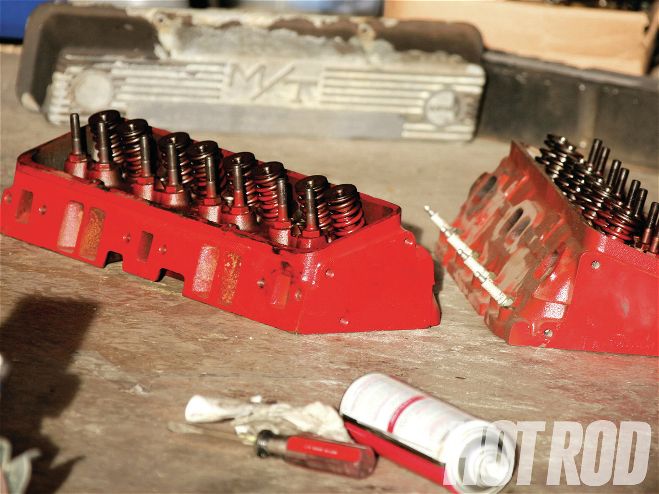
Everywhere we look, guys are running around in rat rods and straight-axle nosebleeders motivated by leftover small-blocks stacked with tunnel-rams, zoomie headers, and other conglomerations of seemingly mismatched speed parts, all in the cause of sights and sounds. But how much does all that stuff really hurt performance? Or does it matter? We decided to find out.
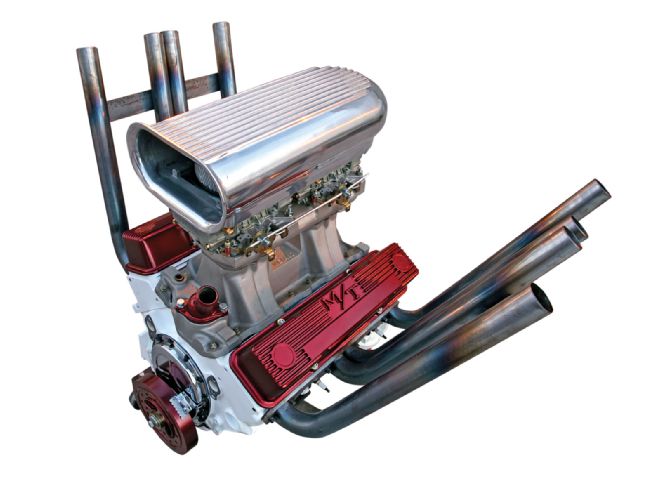 We can’t recall having built an engine so much for looks and not so much for power. Sanderson zoomies FTW! Love it or hate it?
We can’t recall having built an engine so much for looks and not so much for power. Sanderson zoomies FTW! Love it or hate it?
Key to that decision was our hypothesis that we could build the engine in a snap, just like any guy in any garage or carport. Speed was key. You're holding one of those issues of the mag where everything fell apart in the face of freakishly wet SoCal weather and deathbed-level flu for a couple of staffers. We needed to replace some of our planned stories in a jiffy. We pulled this off, but not without some tribulations that—let's face it—you'll probably live through, too.
The Build-Down
The engine we decided to spiff up was a '91 Chevy truck TBI 350—an L05 mill, which was the GM factory code for "laughably underpowered" (190 to 210 hp, depending on trim). It was purchased about 16 years ago, when it was just a youth, from a wrecking yard because we thought we were going to do a smog-legal engine swap. No surprise, that never transpired, and the thing has been collecting dust ever since. It was $1,800 back then. These days, the local Craigslist showed three for sale: $350, $400, and $600. For the price list in this story, we'll call it $500, count our losses, and move on.
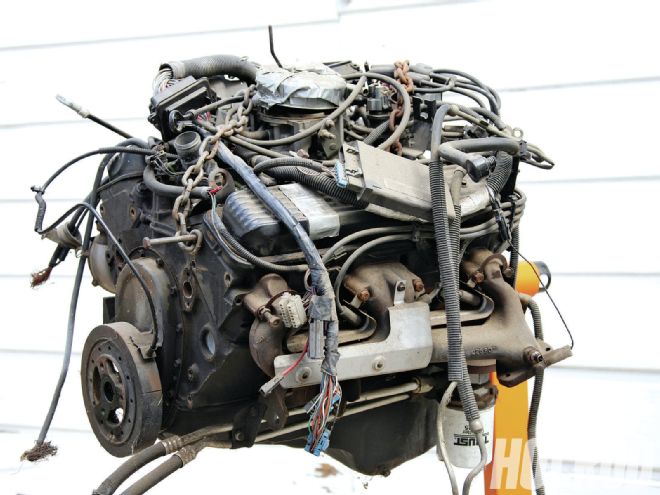 Here’s the slug that gave its all for the cause, an ugly, passé TBI 350. We ended up not using the heads on our core engine, but starting with a complete runner saves a lot of bucks on hardware and tin and dampers and so on.
Here’s the slug that gave its all for the cause, an ugly, passé TBI 350. We ended up not using the heads on our core engine, but starting with a complete runner saves a lot of bucks on hardware and tin and dampers and so on.
Facebook-lurking HRM readers followed what happened during our five-evening adventure. Step one: tear off all the offensive throttle-body-injection junk so we were left with a bare long-block. The '91 mill was not perfect for a retro-looking buildup, but guys with engines like this are never hung up with era correctness, anyway. Glaring non-'60s stuff includes a one-piece rear-main seal (no one sees it), a wrong-side dipstick tube (no one notices), and a mechanical-fuel-pump boss that's cast into the block but not drilled for action. The cylinder heads offer some pains, too, including modern center-bolt valve covers and a nontraditional intake manifold bolt pattern with the center two bolts on each bank being tipped at an unnatural angle. We figured we could overcome that by attacking our manifold with some handheld implement of hogging, and the center-bolt covers can be corrected with adapters.
Wrong and Wronger
The TBI mill was not the coolest option, but likely the cheapest and most readily available in good shape in junkyards these days. The challenge: to polish this turd into an eye-catcher. We raided the paint department at Pep Boys and test-squirted colors onto our spare parts. Dupli-Color makes good stuff, starting with regular engine paints in a range of colors and ending with the neato Metal Specks line of heavy metallics.
 We got our used SR Torquer iron heads for $500 complete, but you can also buy them new at Summit Racing for $509.95 each.
We got our used SR Torquer iron heads for $500 complete, but you can also buy them new at Summit Racing for $509.95 each.
Yeah, we painted it white. Guys did that on some '60s show cars, and we were here to be risk takers. Unbeknownst to us, there's a seething mass of readers clamoring for funky white engines. OK, that's a generous take—but we were shocked by the number of online followers who really dug it. Our favorite snipe was Ted Bixby's when he called it the Stay Puft Marshmallow Mouse. We regret failing to heed Joshua Cripps' suggestion to photograph it under black light.
Our choice then came down to a color for our old M/T valve covers and other details. We painted them metallic black, and then blue, before settling on red, all the while dodging rain and hoping the paint would stick in high-40-degree weather. Freeze-belt readers mocked us for the concern. Casey Thibeault quipped, "That's what the living room is for." Aaron Hoekstra (Hoek'd Up Performance) pointed out that a Harbor Freight Tools infrared body-panel heater will warm a block fairly quickly, and Chris Reid suggested keeping the paint in the house overnight. Two guys said they like to put a trash bag over the engine, then blow into it with a hair dryer to warm it. That sounded a lot like melted trash bag to us.
The Buildup
There was no horsepower goal. We just wanted the 350 to run right and sound cool. Therefore, we used a Comp Cams Thumpr 'stick. We rolled our eyes when the Thumpr line was first introduced, since it was intended less for performance and more for a burger-stand-hero lope thanks to big exhaust duration and lots of overlap. Turns out the Thumprs have been a big hit, and for this engine, the cam not only sounded right but also had specs that were fitting for the weak 350. We chose the smallest of the Thumpr hydraulic flat-tappet units: 227/241 duration at 0.050, 0.479/0.465 lift, and a tight lobe-separation angle of 107 degrees. The stock pushrod length and OE guided rockers had good geometry with the cam. However, the intake lift was on the brink of disaster due to lack of clearance between the valvespring retainers and the valveguides. We could have solved that with a little butchery and felt OK about it, but it was another strike against the heads that were aggressively subpar to begin with.
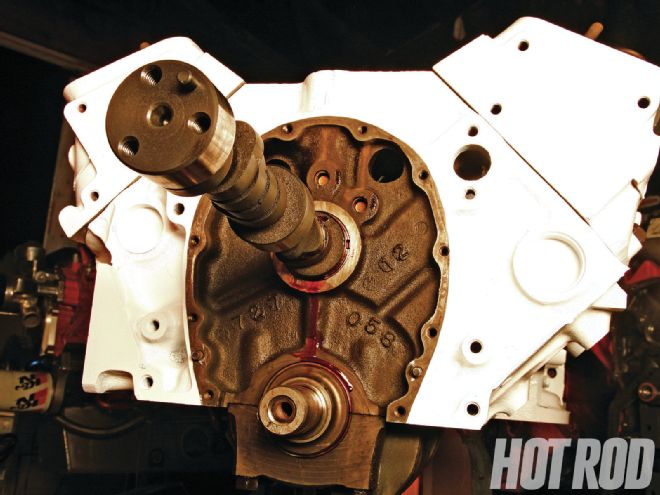 It’s more affordable to buy a flat-tappet cam than a roller, but there’s always the risk of the cam not surviving break-in. This smallest of Thumprs had low valvespring pressures, and we coated it with the lube that Comp provides in the box. You should also make sure to run it in with Comp Cams or Lucas break-in oil. We did, and had no problems after a 20-minute cycle. We were able to use the stock rockers and pushrods with the PN CL12-600-4 Thumpr cam. The ’91 engine uses guided rockers instead of pushrod guideplates, but those rockers must be used with heads that have close-fitting slots for the pushrod holes, just as with the OE heads. Many aftermarket heads don’t have them, but the SR Torquers do.
It’s more affordable to buy a flat-tappet cam than a roller, but there’s always the risk of the cam not surviving break-in. This smallest of Thumprs had low valvespring pressures, and we coated it with the lube that Comp provides in the box. You should also make sure to run it in with Comp Cams or Lucas break-in oil. We did, and had no problems after a 20-minute cycle. We were able to use the stock rockers and pushrods with the PN CL12-600-4 Thumpr cam. The ’91 engine uses guided rockers instead of pushrod guideplates, but those rockers must be used with heads that have close-fitting slots for the pushrod holes, just as with the OE heads. Many aftermarket heads don’t have them, but the SR Torquers do.
Having posed our dilemma to the readership, we were accused of pulling the ol' magazine guy, "we happened to have Brodix aluminum heads sitting around" trick. That would have been bogus for our price list and a waste of good parts on a quickie engine. Instead, we blazed through Craigslist ads and found the perfect solution: used World Products SR Torquer iron, 170cc heads already loaded with the right valvesprings. They solved the lift problem and eliminated the need for valve cover adapters and molesting the intake boltholes. They're also maybe 20 hp better than the stock wheezers.
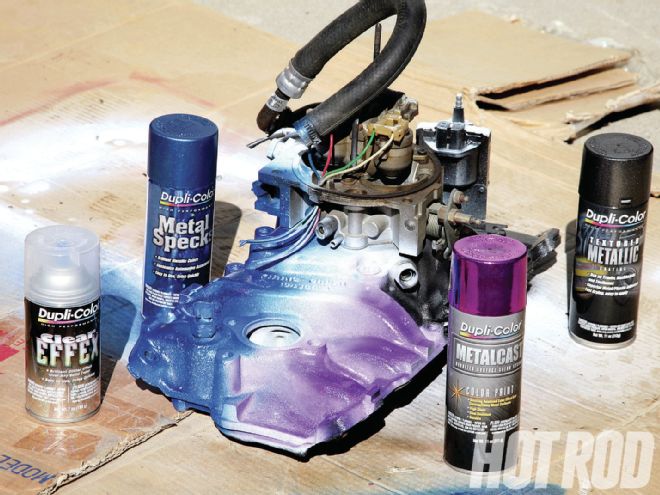 We spent an unreasonable amount of time fiddling with various Dupli-Color spray paints. At the left rear is blue Metal Specks on its own, and at left front is the Metal Specks under the sparkly Clear Effects stuff. At right front is a can of the Metalcast, which is intended to make an anodized look over chrome. We tried it over white and it was not cool, but using it over the blue Metal-Speck was very neat. A darker purple was made using the Metalcast over graphite-colored Textred Metallic Coating (right rear). Any of these can be made richer with clear engine paint.
We spent an unreasonable amount of time fiddling with various Dupli-Color spray paints. At the left rear is blue Metal Specks on its own, and at left front is the Metal Specks under the sparkly Clear Effects stuff. At right front is a can of the Metalcast, which is intended to make an anodized look over chrome. We tried it over white and it was not cool, but using it over the blue Metal-Speck was very neat. A darker purple was made using the Metalcast over graphite-colored Textred Metallic Coating (right rear). Any of these can be made richer with clear engine paint.
Our bone stock L05 engine had the pistons 0.027 in the hole and the dishes and valve reliefs added up to a 12cc compression penalty. The stock heads had 65cc chambers; the SR Torquers were 67 cc. We saved some compression and made a marginal improvement to the quench by using 0.016-inch-thick steel shim head gaskets (Fel-Pro PN Q7733SH1). Those are old school, cheap, and good for 9.14:1 compression.
Hold Your Horses
We entered the dyno test with a best-case intake and exhaust combo: an Edelbrock Air-Gap dual-plane with a Holley 750 HP carb, and exhaust shooting through under-chassis headers with 1 5⁄8-inch tubes, 3-inch collectors, and 18-inch collector extensions.
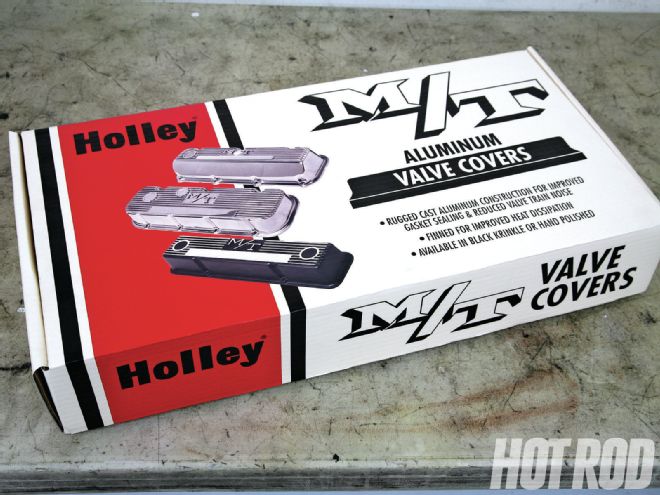 How cool! We spent a lot of time restoring and painting (red) an ancient set of M/T valve covers, but then Holley sent us the very first set of their brand-new reproductions! They come in this retro packaging that was worth a photo.
How cool! We spent a lot of time restoring and painting (red) an ancient set of M/T valve covers, but then Holley sent us the very first set of their brand-new reproductions! They come in this retro packaging that was worth a photo.
Hooked up to Westech's SuperFlow 902 dyno, the glowing Marshmallow Mouse looked like a new pair of sneakers. They got stepped on quickly, as we apparently have no clue how to seal the back of an intake manifold. During cam break-in, we got enough oil on the headers to start a fire. Our pearly white was now slightly singed and streaked with yellow oil stains. At least we got that out of the way early.
Final answer: 352 hp at 5,300 rpm and 394 lb-ft of torque at 4,100 rpm. We asked readers to guess the power with this setup. The lowest entry was 265 hp and the highest was a glue-sniffing 535. Jim Brenner was closest with the power numbers, estimating 356 hp at 5,700 and 392 lb-ft at 3,600.
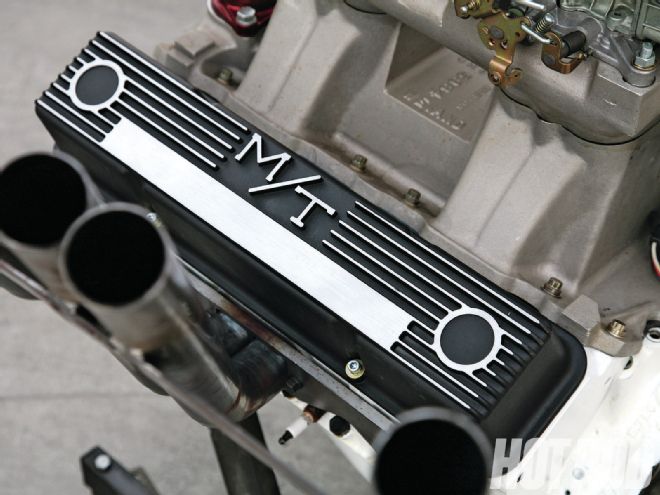 The new M/T covers will be available black or polished for small- and big-block Chevy and big-block Ford engines. They will be delivered without any holes in them for breathers or oil fills; you can use them on intakes with breather tubes or cut holes to suit your needs.
The new M/T covers will be available black or polished for small- and big-block Chevy and big-block Ford engines. They will be delivered without any holes in them for breathers or oil fills; you can use them on intakes with breather tubes or cut holes to suit your needs.
Tunnel-Ram
The moment we were all waiting for: a Weiand tunnel-ram and twin Holleys. This is the de facto setup for countless rods these days, and you can hardly walk through a swap meet without stubbing a toe on the stuff. You can also get it all new as a Pro Pack kit from Summit Racing that includes the manifold, two carbs, and the linkage.
What separates our induction from the norm is a pair of unusual, 450-cfm Holley four-barrels instead of the standard 600-cfm, 1850-type vacuum secondaries. The 450s are weird because they have mechanical secondaries but they are not double-pumpers; they have no secondary accelerator pumps. They also have metering blocks up front only, not in the back. These carbs are kinda cool for a tame engine like ours because they are small for snappy response, and the engine does not need four squirters shooting fuel every time you mash the throttle, so two are enough. The downside is that the carbs have a limited range of fuel-curve tuning and probably should not be used on anything wilder than, say, 400 hp. But they also don't have the vacuum secondaries that can be rough to get working properly on a deal like this. Summit also sells a kit with the regular 600 carbs, if you prefer, and it's even $4 cheaper. Incidentally, the tunnel-ram kits are sold for big-block Chevys, big- and small-block Fords, 351C Fords, and big- and small-block Mopars.
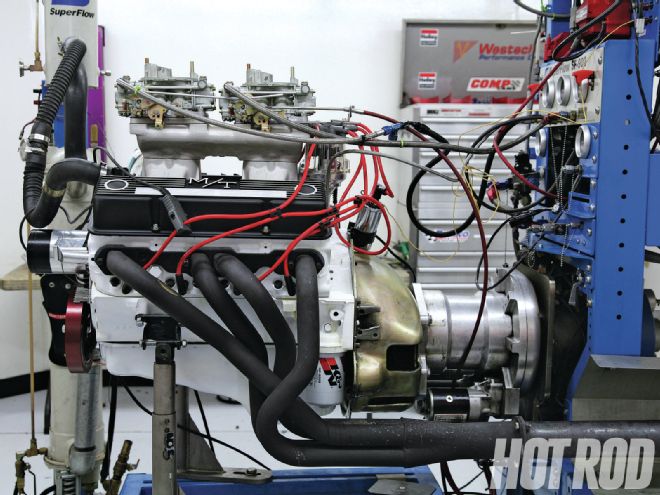 Step one on the dyno was with a conventional Air-Gap intake and a Holley 750 HP carb, then we swapped to the tunnel-ram. Even if you can’t get past the white paint, this story gives you an easy recipe for a dirt-cheap 350hp, 390 lb-ft, 350-inch small-block.
Step one on the dyno was with a conventional Air-Gap intake and a Holley 750 HP carb, then we swapped to the tunnel-ram. Even if you can’t get past the white paint, this story gives you an easy recipe for a dirt-cheap 350hp, 390 lb-ft, 350-inch small-block.
But will it run? Popular consensus said no (such as, "Dude, that's overkill. That engine can't handle a tunnel-ram," per Bob Bator). The dyno said yes. Past experience had us presuming that the tunnel-ram would improve the entire power curve. Instead, it was unaffected below 4,200 rpm, which is where the tunnel-ram pulled away on its climb to a new peak power number of 364 at 5,400, a minor gain of 12 hp. Torque remained virtually unchanged at 396 at 4,200.
But you don't drive a dyno. We can tell you that the engine fired up instantly, just as it did with the Air-Gap (though cold starts can be time killers with a tunnel-ram). It also idled at 850 rpm and 13.1:1 air/fuel ratio, just like with the single quad. Barking the throttle straight to wide open provided only a very slight hesitation, easily solved with bigger squirters. In the type of 2,400-pound cars that engines like this wind up in, we can't imagine why you could not drive it anywhere and make plenty of tire smoke.
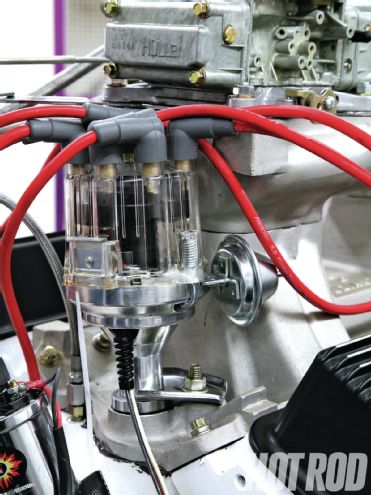 We used a Mr. Gasket clear distributor cap for the look that wins. The distributor is a PerTronix unit chosen because it uses the same ignitor ignition module you can buy to fit inside any stock distributor you want to use for a retro look. Fun fact: We ran the engine on the same spark plugs it had when it came from the junkyard 16 years ago.
We used a Mr. Gasket clear distributor cap for the look that wins. The distributor is a PerTronix unit chosen because it uses the same ignitor ignition module you can buy to fit inside any stock distributor you want to use for a retro look. Fun fact: We ran the engine on the same spark plugs it had when it came from the junkyard 16 years ago.
Cherry Bombs
How can you do a retro test without the ultimate '60s muffler? Cherry Bomb glasspacks are classics, and they now have the red coating sorted out so they don't turn pink under heat. There are many diameters and lengths of these mufflers in the line, but we used the 20-inchers that bolt to the header flanges (PN 87554). We kinda wish we had also had the side-pipe–length ones.
With the Bombs, power only fell by 2 to 7 numbers, depending on where you looked in the curve. No big loss. We can't say the engine was a whole lot quieter, but that alone seems to be the point—it had more burble.
Zoomies!
If we were excited to try the tunnel-ram, then we were virtually hysterical over the zoomie headers. Not familiar with the term? Zoomies are like dragster or Funny Car headers, with four individual tubes per side and no collectors. They look cool and sound radical, but they're not known for working magic on low-po engines. We had to find out just how badly they'd hurt performance.
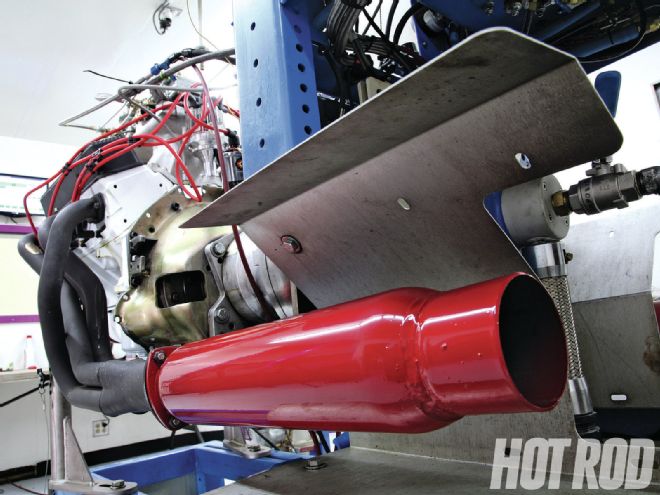 The Cherry Bombs killed hardly any power and cut hardly any noise. We liked it that way.
The Cherry Bombs killed hardly any power and cut hardly any noise. We liked it that way.
We know Sanderson as a maker of really nice, well-fitting, street rod and muscle car headers with a number of block-hugger and long-tube applications, including many for oddball engines. No surprise that the company also has two styles of zoomies (upswept and downswept) as well as various designs of lakester and Limefire headers that are popular for retro rods. We asked Sanderson to send us a set of the very basic, uncoated Chopsters with an extreme upward rake. They looked sooooo bitchin'!
We were bouncing off the walls when we first fired the 350 with the zoomies and they shot fire and sparks out of every tube for a few minutes. Sadly, that stopped when the welding slag was burned out. Dang it. We were like little children trying to retard timing and fatten up the carbs to make more fire. No success. But you have to go see our video and check out the sparks.
On the real tune-up, as expected, we still lost 10 to 20 hp most places in the curve even though the peak horsepower was not badly affected. The new peaks were reduced to 354 at 5,400 and 378 lb-ft at 3,900. Like you'd notice. Besides, what's horsepower really matter when chicks are diggin' you?
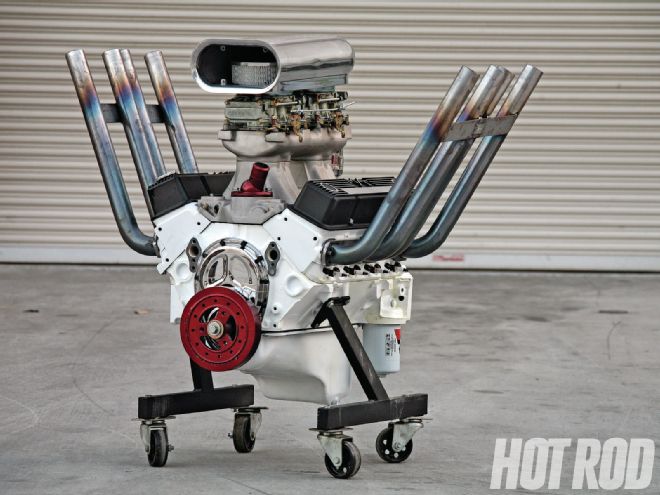 The topper is this scoop setup from Summit Racing, PN SUM-G3008 for $147.95. It is for dual quads and is adjustable to fit various center-to-center specs for different intake manifolds. It’s meant for carbs with a 51⁄8-inch flange, like a typical Holley or Edelbrock. The scoop comes with two filters and a front mesh screen (that we didn’t use). We want to paint the ridges in the top in the same red we used on the valve covers—which needed the fins sanded bare—and the damper.
The topper is this scoop setup from Summit Racing, PN SUM-G3008 for $147.95. It is for dual quads and is adjustable to fit various center-to-center specs for different intake manifolds. It’s meant for carbs with a 51⁄8-inch flange, like a typical Holley or Edelbrock. The scoop comes with two filters and a front mesh screen (that we didn’t use). We want to paint the ridges in the top in the same red we used on the valve covers—which needed the fins sanded bare—and the damper.
See and Hear This Engine on Video Now
Throughout our dyno test we were shooting video and audio so you can hear our Rat 350 at idle and at full scream in three combinations: with open headers, with Cherry Bombs, and with the zoomies. Get a few more tech tips and watch our dyno day by looking for the video now on HOTROD.com's video page or at YouTube.com/HotRodMagazine.
What's the Price of Glory?
The list here shows the price to replicate our final configuration of the engine with the tunnel-ram and the zoomies. This includes everything from oil to degreaser and paint, but does not include the valve covers because the new reproduction M/Ts had not been priced as of press time. There isn't anyone reading who could not whack at least $600 off the prices with some scrounging.